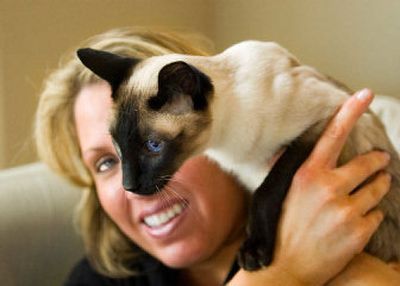Some pay premium for healthy pets

Scout has had some health problems the last few years – a urinary tract infection, food allergies, a couple of dental extractions – nothing too serious or surprising for a cat that’s getting a little long in the tooth.
But unlike most pets, Scout, a 12-year-old Siamese, belongs to one of a growing number of people who have veterinary insurance. For the last two years, Jennifer Martone has paid annual premiums of $488 to Veterinary Pet Insurance of Brea, Calif., the nation’s oldest and largest pet insurer.
“Animals are expensive, but they’re worth it,” said Martone, a Spokane County resident who works part time as a waitress and is married to a deputy sheriff. “We don’t have kids, and she’s my baby.”
A survey by the American Animal Hospital Association showed 94 percent of pet owners attribute human personality traits to their pets. More than two-thirds have included their pets in holiday celebrations and one-third characterize their pet as a child, said Brian Iannessa, a VPI spokesman.
This may explain why VPI wrote $110 million in premiums last year. It currently has 369,000 active policies, 60 percent of the pet insurance market, a number Iannessa considers paltry, considering there is at least one pet in 69.1 million American homes.
VPI insures pets in every state and the District of Columbia, including 9,071 pets in Washington state, which is among the fastest growing states in terms of new enrollments, Iannessa said. VPI has 246 policies in Spokane and 37 in Coeur d’Alene.
Much like human health care, Iannessa said, veterinary medicine is becoming increasingly more sophisticated and expensive. Veterinary services in 2003 cost $85 million nationally, up from $4.8 million in 1994.
Animals are being treated more because there are more alternatives for care. Veterinary oncology is now a very real option, and the pet food company Iams recently opened an animal imaging center in California.
“Someone once insured a Guinea pig,” Iannessa recalled. “It was being treated with laser technology for kidney stones while it was hooked up to a monitoring device to check his vitals.”
Ear infections in dogs and dermatitis and eye infections in cats are still among the most common claims, but there is also the occasional constipated snake. VPI covers exotic pets, birds, even frogs and mice, but 83 percent of animals the company insures are dogs, and 15 percent are cats.
The average VPI premium is about $25 a month, but a rider can be added to double benefits for cancer treatment. VPI’s “superior” plan provides up to $4,500 per incident up to a maximum annual benefit of $14,000.
VPI is not managed care. Iannessa said he doubted veterinarians would go for that. Instead, it’s an indemnity-type insurance in which the customer pays the veterinarian and then submits a claim to the insurer that includes an itemized receipt and a form that includes the veterinarian’s signature along with the diagnosis.
“You can go to any licensed vet and use it as a portable policy,” Iannessa said. “We don’t market outside the U.S., but you can use it abroad.”
About 1,300 U.S. companies, including Ford, Google and AOL, offer pet insurance to their employees at group discounts, Iannessa said.
Martone said pet insurance provides “peace of mind” that she can make the best decision for Scout based on necessity, not how much veterinary care she can afford.
“It makes me feel confident knowing I will get a good percentage of that back,” she said. “I take her to the vet more often because I know it won’t be such a financial hardship.”